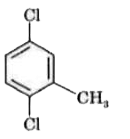Which of the following pairs do not represent two resonance structures and why?
(i) 
(ii) 
(iii) CH3COCH3andCH3−OH∣C=CH2
(iv) 
(v) CH3CH=CHCH3andCH3CH=CH2
The two structures which differ in the position of atoms ar not resonance structures. Thus the pair of structures given in (i), (iii) and (v) do not represent resonance structures.
Topper's Solved these Questions
- ORGANIC CHEMISTRY : BASIC PRINCIPLES AND TECHNIQUES BOOK - CHHAYA PUBLICATIONCHAPTER - ORGANIC CHEMISTRY : BASIC PRINCIPLES AND TECHNIQUES EXERCISE - SHORT - TYPE QUESTIONS
17 Videos
- MODEL QUESTIONS PAPER BOOK - CHHAYA PUBLICATIONCHAPTER - MODEL QUESTIONS PAPER EXERCISE - SET III (SECTION II) (GROUP D )
12 Videos
- P-BLOCK ELEMENTSBOOK - CHHAYA PUBLICATIONCHAPTER - P-BLOCK ELEMENTSEXERCISE - PRACTICE SET 7 (ANSWER THE FOLLOWING QUESTIONS) : -
17 Videos
Similar Questions
Knowledge Check
Following compounds are given
(i) CH3CH2OH
(ii) CH3COCH3
(iii) CH3−C∣CH3HOH
(iv) CH3OHA(i), (iiii) and (iv)Bonly (ii)C(i), (ii) and (iii)D(i) and (ii)In which of the following pairs of carbocations, the first carbocation is more stable than the second ?
(i) CH2=CH−CH2andCH2=CH−CH2−+CH2
(ii) CH3−NH−+CH2and+CH2−OH
(iii) CH3−O−CH2−+CH2andCH3−O−+CH2
(IV) CH3+CH−CH2CH2CH3andCH3CH2−+CH−CH2CH3A(i),(ii) and (iii)B(i) , (ii) and (iv)C(ii) and (iii)D(iii) and (iv)
Which structural isomerism is exhinited by the following pairs :
(i) CH3−(C)−OH and (C)−O−CH3H- (ii) CH2=CHOH and CH3−O||C−H
(iii) CH3−CH2−CH=CH2 and CH3−CH=CH−CH3
(iv) CH3−CH2−CH2−NH2 and CH3−CH|NH2−CH3
View SolutionWhich structural isomerism is exhibited by the following pairs :
(i) CH3−O||C−OH and H−O||C−O−CH3
(ii) CH2=CHOH and CH3−O||C−H
(iii) CH3−CH2−CH=CH2 and CH3−CH=CH−CH3
(iv) CH3−CH2−CH2−NH2 and CH3−CH|NH2−CH3
View SolutionWrite IUPAC names of the following compounds :
(i) CHF2CBrClF (ii) ClCH2C≡CCH2Br (iii) CH3CH=CH−CH3∣C∣Br−CH3
(iv) (CH3)2C=CHCH2Cl (v) (CH3)3CCH(Cl)CH(CHBrCH3)CH2CH2CH(CH3)2
(vi) (vii) CH3−CH3∣C∣CH3−Cl
(vii) CH3−CH3∣C∣CH3−Cl
View SolutionWrite IUPAC names of the following compounds :
(i) CHF2CBrClF (ii) ClCH2C≡CCH2Br (iii) CH3CH=CH−CH3∣C∣Br−CH3
(iv) (CH3)2C=CHCH2Cl (v) (CH3)3CCH(Cl)CH(CHBrCH3)CH2CH2CH(CH3)2
(vi) (vii) CH3−CH3∣C∣CH3−Cl
(vii) CH3−CH3∣C∣CH3−Cl
View SolutionWhich alkyl halide from the following pairs would you expect to react more rapidly by an SN2 mechanism? Explain your answer.
(i) CH3CH2CH2CH2Br or CH3CH2C∣BrHCH3 (ii) CH3CH2C∣BrHCH3 or H3C−CH3∣C∣CH3−Br
View SolutionWhich alkyl halide from the following pairs would you expect to react more rapidly by an SN2 mechanism? Explain your answer.
(i) CH3CH2CH2CH2Br or CH3CH2C∣BrHCH3 (ii) CH3CH2C∣BrHCH3 or H2C−CH3∣C∣CH3−Br
View Solution
